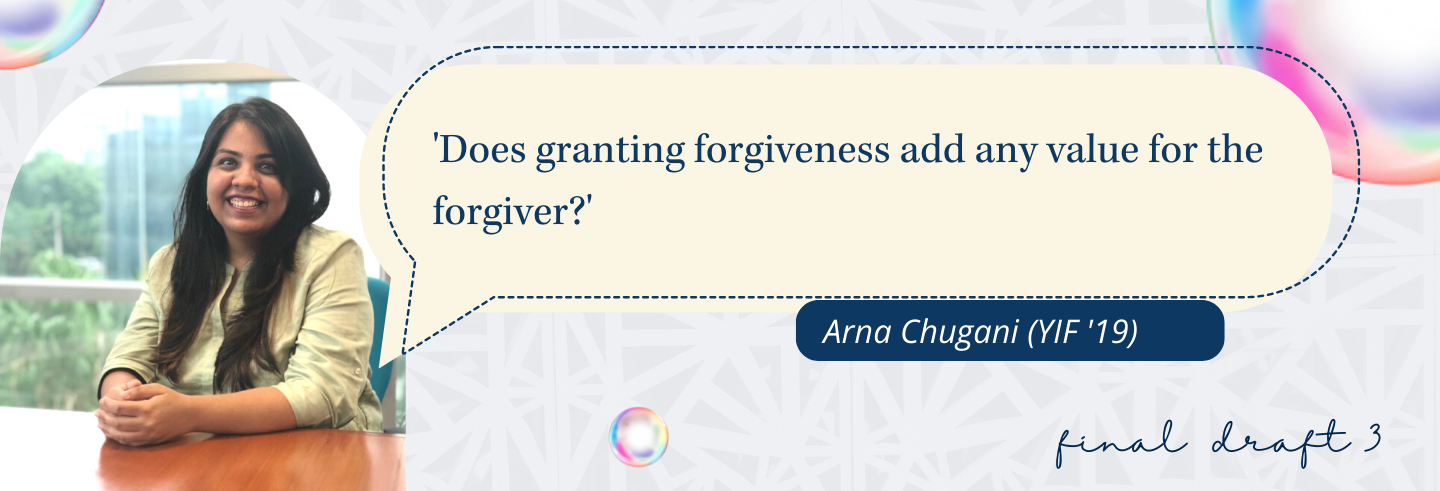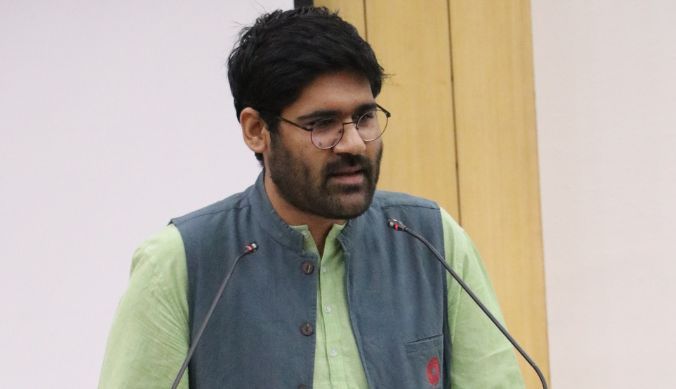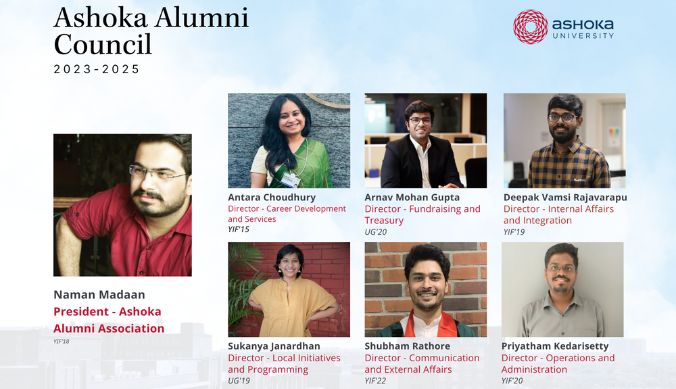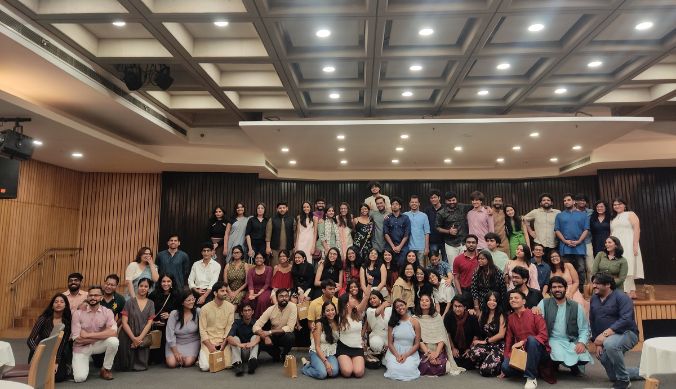‘The Heart of the Mind: The Rationale of Forgiveness’
Featuring Arna Chugani’s creative piece that developed as an original project over her term at the Young India Fellowship

Arna S Chugani
11 October, 2022 | 6m readAbstract:
The author questions the entrenched divide between the rational and the emotional and argues that there exists osmosis between the two and that they are not watertight. It looks at forgiveness and analyses its processes as an example, to take this argument forth.
Article:
As I walked through a door of hurt,
I stumbled upon a door that
could help me heal.
My heart sang a song of relief, while
my mind questioned if it would be
forced to seal.
The conversation enveloping the boundaries between the rational and the beyond rational, between the scientific and the philosophical, between enquiry and faith, between reason and intuition, has been an ongoing debate, and it may well be an eternal one. During my year at the Young India Fellowship (YIF), I often found myself at a crossroads: on one end, an endeavour to develop the tools to think critically, and on the other, a calling to embark on a personal journey of healing and emotional transformation. I drew my boundaries, and two camps of thinking emerged as conflicting flag-bearers: the rational school of thought and the emotional one. The paper positions itself as a medium of enquiry into the strength and validity of this inner conflict and contends that there is an inherent osmosis between the rational and the emotional. I question the demarcation through the lens of forgiveness—a concept that I had associated with being spiritual and emotional (and therefore, as an outlier to the rational school of thinking). I attempt to break down my understanding of forgiveness in its philosophical and metaphysical components and unfold these components to encounter a plausible thread of rationality within them.
At the outset it would be pertinent to acknowledge an important disclaimer that would contribute to the reader’s comprehension of this paper. Through history, philosophy, science, and spirituality, authors, scientists, and thinkers have defined the multiple theories of knowledge in a multitude of ways. I have taken the liberty of using a handful of words interchangeably. Reason, rationality, science, and logic have been tied together; and emotional cognisance, philosophy, metaphysics, and spirituality in another bundle. As I consciously follow this rather crude approach to funnel the focus of the enquiry, I acknowledge that each of these words has its own definitions, and I will keep in mind the limitations and the complexity of terminology that I engage with.
The Fortified Borders

Kansas City, United States: Andrews McMeel
Publishing, 2015
The game of chess between two schools of thinking has not only been a personal conflict but has also been a chapter of interest in the world of academia and philosophical pondering. Demonstrating how the emotional school of thought has been checkmating the rational school of thought, David Best in his paper “Education of Emotions: The Rationality of Feeling” writes, “The root of the trouble is the largely unquestioned assumption that pure emotional feelings are ‘direct’, in the sense of being ‘untainted’ by cognition, understanding and rationality” (Best, 240). Best, in his paper, theorises the possibility of ‘educating’ one’s emotions, thus in the process, attaching them with reason, and brings to the reader the proposition of adding such education to mainstream education. The ‘trouble’ Best talks about is the growing independence of rationality from emotion, a phenomenon he largely attributes to the perceived purity and individuality that followers of the emotional school of thought assert over their contemporaries. This game of chess is not a one-sided game either. The rational school of thinking has its own moves in this debate. Historian and philosopher Frank Thilly in his paper “Psychology, Natural Science and Philosophy” draws attention to this demarcation between the two repositories of knowledge and writes,
…Psychology too cut loose from her old-fashioned sisters (aesthetics, ethics, epistemology, metaphysics). … The introduction of laboratory methods into psychology has given it a scientific savor, and the experimentalists are often ashamed of the company they are forced to keep. They have greater respect for the kind of work done by the natural scientists, who are apt to smile at the pretensions of the philosophers … (Thilly, 131).
Though they do not claim the superiority of one school of thought over the other, both Best and Thilly indicate that the boundaries between the two theories of knowledge appear not just distinct from each other, but also seemingly at loggerheads with each other. It appears that the ardent enthusiasts of the two schools use the innate essence of their school to question the validity of the other in the quest for meaning-making.
The divide is not a closed chapter of the past. One may claim, and rightly so, the visible existence of this debate in contemporary academia even in times as recent as ours. Professor Massimo Pigliucci of the City University of New York comments in his essay “The Demarcation Problem” about the long-lived will-power of this debate,
The fact that we continue to discuss the issue of demarcation (between science and pseudoscience, or metaphysics) may seem peculiar, though, considering that Laudan (in 1983) allegedly laid rest to the problem … (Laudan) concluded that … if we would stand up and be counted on the side of reason, we ought to drop terms like ‘pseudoscience’ … from our vocabulary. (Pigliucci, 10)
In this paper, Pigliucci challenges Larry Laudan’s much referenced paper “The Demise of the Demarcation Problem” (written in 1983 in the book of essays Physics, Philosophy and Psychoanalysis) which was then renowned for bringing an end to the demarcation problem between science and pseudoscience. Laudan rendered pseudoscience meaningless and thus conferred the authority of meaning-validity to scientific enquiry and empirical evidence. Pigliucci, by challenging Laudan’s claim, brings back to philosophical enquiry the ‘demarcation problem’ that probably never left the question bank.
The question of this demarcation is not only a philosophical and academic pursuit. Digital cartoonist Nick Seluk encapsulates this very demarcation problem in his cartoon strips under the trademark The Awkward Yeti. What started out as a book that became the New York Times Bestseller has now found resonance with its 2.3 million followers on Facebook. Two protagonists in Seluk’s world, the heart and the brain, have their individual personalities. While Heart seems free-spirited, carefree, sometimes ‘irrational’, and always with her ‘heart’ on her sleeve, Brain in these pages appears to be rational, a planner, a believer in action over word, sometimes with traits of a ‘classic overthinker’. The conversations between Heart and Brain form the vessel for Seluk’s creative pursuit. Sometimes in deep thought, sometimes in questions of distress, and sometimes simply in routine conversation, the two often appear to be at a crossroads, each one traversing a path different from the other. With visual representation of the age-old demarcation problem, his content reminds us that the tug of war between the heart and the brain is a common, shared experience.

March 2019,
https://www.facebook.com/
AwkwardYeti/photos/a.323340867741595/2118
480981560899/?type=3&theater. Accessed 12
August 2021
The Blurring Borders
“The misunderstanding of passion
and reason, as if the latter were an
independent entity … and as if every
passion did not possess its quantum of
reason.”
Friedrich Nietzsche (Nietzsche, 208)
Through this section, I question the established divide through the lens of forgiveness—a tool that I had often associated solely with an emotional and spiritual significance. The enquiry into the seemingly complex realm of forgiveness begins with an observation of the ambivalence that could be attached to forgiving the forgivee. In The Book of Joy, Douglas Abrams scripts the unfolding of the five-day conversations between the Dalai Lama and Archbishop Desmond Tutu as they discuss a question that has been one of spiritual enquiry, the question of finding joy in the midst of ‘inevitable suffering’. In one such conversation that steered towards forgiveness, the Dalai Lama emphatically says,
There is an important distinction between forgiveness and simply allowing others’ wrongdoing. … Where the wrong action is concerned, it may be necessary to take appropriate counteraction to stop it. Toward the actor, or the person, however, you can choose not to develop anger and hatred. This is where the power of forgiveness lies—not losing sight of the humanity of the person while responding to the wrong with clarity and firmness. (Dalai Lama, 234)
The Dalai Lama calls for a distinction between the doer and their actions, and maintains the distinction between ‘Chinese hard-liners’ and their actions that caused the people of Tibet pain and suffering. Questions of whether the two are distinguishable, and thus whether a person does have agency over her actions arise from this read. However, for the purpose of this paper, I draw your attention to the last statement in the quote. The forgiver, he seems to suggest, is one who does not do nothing about the situation she finds herself suffering in, yet recognises the perpetrator as a fellow human, thus focusing her remedial response on the wrongdoing and not on the wrongdoer. Attempting to unravel the steps in this process, it appears that the pursuit of the path that the Dalai Lama suggests would begin with taking a step back, detaching the self from the pain, and almost sitting on the fence of neutrality as an observer. Sitting on the fence is what comedian Tim Minchin recommends in his “anthem to ambivalence”.1 Talking about worshipping a fellow human without accounting for his flaws, Minchin’s song plays, “You can’t see which grass is greener. Chances are it’s neither, and either way it’s easier, to see the difference, when you’re sitting on the fence” (Minchin). Minchin challenges the tendency of an absolute binary classification and tells his viewers to hold back from dividing the world “into wrong and into right”. It is almost ironic to connect his quote to the quote of the Dalai Lama’s since Minchin through his song satirises the glorification of the Dalai Lama as well. However, what Minchin suggests for political awareness, can be drawn to what the Dalai Lama suggests for forgiveness awareness: the very necessity of taking a step back and sitting on the fence, before making a judgement.
Once we find a comfortable abode on the fence, it would be insightful to question whether there would be a return on the investment of time and effort that would go into the process of forgiveness. That is to say, does granting forgiveness add any value for the forgiver? Colin Tipping, life coach and author of Radical Forgiveness: Making Room for the Miracle, is likely to answer in the affirmative. He writes, “He (the wrongdoer) provided you with an opportunity to get in touch with your original pain and to see how a certain belief about yourself was running your life. In doing so, he gave you the opportunity to understand and change your belief, thus healing your original pain. (This understanding is) what I mean as forgiveness” (Tipping, 26). Asserting that the act of ‘radical forgiveness’ is fulfilled when the identity of victimhood is replaced by the identity of a student, Tipping suggests that the pain one undergoes as the consequence of an action that requires forgiveness is in fact an opportunity to learn about and to heal an earlier stimulus. This opportunity makes the process of forgiveness not only a function focused solely on the absolution of the forgivee. A part of the equation also includes an added value for the forgiver, potentially implying that forgiveness is not only an altruistic concept in its entirety.
Moving along the forgiveness decision tree, once the added value is identified, it is now the agency of the potential forgiver to forgive or exercise their right to refrain. Testament to exercising this agency is the short-lived life cycle of the Asian Women’s Fund (AWF). The fund was set up by the Japanese government in 1995 as an apologetic compensation for the ageing former ‘comfort women’—women and girls who were taken (by several historical accounts, forcibly) into wartime sexual slavery and held in ‘comfort stations’ near the Japanese military base camps during World War II (Brown et al., 217). At the time, an ongoing debatable number of 1,00,000 to 2,00,000 comfort women were taken captive from South Korea, China, the Philippines, Taiwan, and the Netherlands, among other geographies (Yoshimi). The Government of Japan set up a fund comprising $4.8 million raised from private contributions and $6.3 million from the state to fund ‘welfare services’ for the women who survived the systematic rape and sexual slavery by the then Japanese military. The women who accepted the funding, thus gesturally forgiving the state, would each receive $17,000, accompanied by an apology letter signed by Japan’s then Prime Minister Junichiro Koizumi (Koizumi). A minuscule fraction of the estimated number of former comfort women accepted the apology compensation by the time the fund closed. In 2015, the foreign ministries of Japan and South Korea struck a deal of $8.3 million in return for South Korea absolving Japan for the actions of its former military. This fund, meant for the welfare of the women captured from the then annexed South Korea, was planned to be used for the welfare of the state instead (Berenson). An emphatic Facebook video shows the exchange of dialogue between a former comfort woman and the then vice minister of foreign affairs, Lim Sung-nam. The victim is seen repeatedly questioning the minister on the grounds of negotiations between the two states, “Shouldn’t you have met the victims first before you do that [agree on the settlement]. … Are you going to live this life for me? … How could you do this, when we are alive as witness [sic] and evidence of history?” (Lim). Forgiveness, these women reaffirm, is a process undertaken after an analysis of the act of perpetration versus the authenticity of the apology, and is an agency that rests with the victim of the crime.
Through the above paragraphs, I see three key milestones en route to forgiveness. One, a focus on objective segregation by taking an almost third-person view from the fence. Two, a pursuit of weighing the value it provides to the forgiver. Three, a restoration of the agency of choice in the hands of the forgiver. This prompts me to reconsider my former compartmentalisation of the concept of forgiveness as a solely mystical process—rather, the decision to forgive comprises within its realm processes that are likely to be identified and understood, if the cloud of demarcation between the rational and the beyond, between reason and spiritual, is open to the possibility of weakening in strength, even if not dissolving completely. Today, my spiritual journey enjoys the presence of reason, analysis, and critique: sometimes playing the devil’s advocate, at times solidifying my trust in the process. As a result, I sometimes find myself in the midst of increased chaos, and sometimes approaching greater clarity. What has, however, been relatively more constant is the presence of a deeper internal dialogue.
About the Author:
In her pre-YIF life, Arna’s relationship with writing was built on the foundation of a rich experience in drafting emails (‘Thanks & Regards’ was once her favourite sign-off) and adding bullet points on her PowerPoint slides. For someone who was convinced that the Critical Writing course would be her doomsday device, it surprisingly turned out to be a truly revelatory experience for her at the fellowship. Through the process of writing for the course, and the resolve of her preceptor Anunaya Rajhans, she discovered a channel of communication with texts, authors and ideas, and more significantly, with her own self. Today, she doesn’t really consider herself to be a skilled writer, but writing does help her see herself – it helps her observe her thoughts, her patterns and her process of meaning-making.
Arna sees her career trajectory as a journey of connecting the dots. Completing her Chartered Accountancy in 2015, she worked as a Forensic Consultant in PwC and as an independent auditor. Post the Young India Fellowship in 2019, she joined Egon Zehnder as a Leadership Advisory Specialist, working on leadership assessment & team development projects. She currently works with the firm as a Programme Manager for an intensive senior leadership development project.
She is intrigued about the intersection of self-discovery and leadership development, and aims to further her career in this space. On the weekends, she is a lazy bug and a passionate Toastmaster.
About YIF CW Programme:
The YIF Critical Writing programme is a unique, one of a kind opportunity for Fellows to hone their critical thinking and writing skills under the able supervision of trained experts in the field. The CW programme employs a constantly evolving pedagogy, making learning and knowledge production more collaborative and dialogic. Preceptors at the YIF CW programme teach writing through a range of topics including but not limited to ‘History, Philosophy, and Anthropology of Science’, ‘Politics of Language and Multilingualism’, and ‘Education, Literacy, and Justice’.
About Final Draft:
The Final Draft is the annual journal of the YIF Critical Writing programme. It showcases the range in topic and genre, as well as the strength of writing in the highly diverse YIF student body. These pieces of writing, submitted by Fellows from various classes of the YIF represent only a small fraction of the variety and range of writing done over the years.
About our campaign:
Through our ‘Final Draft 3’ campaign, we hope to give you a glimpse into some of the styles and voices that have evolved, the concerns and ideas that fellows have explored, and the seriousness of their engagement with writing as drafts in motion; searching for meaning and connection, which makes this more of a pedagogic exercise book.
(This piece was first published in the Final Draft, A Journal of the YIF Critical Writing Programme.)













